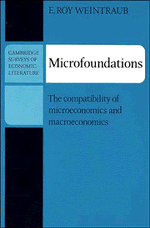4 - The neo-Walrasian synthesis
Published online by Cambridge University Press: 03 May 2011
Summary
J. R. Hicks' Value and Capital, published in 1939, is rightly considered a classic in economics for its rigorous treatment of household and firm behavior under competitive conditions. What is less frequently appreciated today is that it was an attempt to lay the conceptual groundwork for macroeconomics in a well specified Walrasian system.
I believe I have had the fortune to come upon a method of analysis which is applicable to a wide variety of economics problems … it is, perhaps, most illuminating when it is applied to the most complex problems (such as those of trade fluctuations) … The method of General Equilibrium, which these writers [Walras, Pareto, and Wicksell] elaborated, was especially designed to exhibit the economic system as a whole, in the form of a complex pattern of interrelations of markets … When we come to dynamic problems, I shall not neglect to pay attention to the important work which has been done in that field by Marshallian methods—I allude in particular to the work of Mr. Keynes … [with our methods] we shall thus be able to see just why it is that Mr. Keynes reaches different results from earlier economists on crucial matters of social policy
[pp. 1–5].The structure of Value and Capital itself reflects Hicks' absorption with microfoundations topics. Initial chapters present the theory of consumer behavior and general equilibrium of exchange.
- Type
- Chapter
- Information
- MicrofoundationsThe Compatibility of Microeconomics and Macroeconomics, pp. 55 - 68Publisher: Cambridge University PressPrint publication year: 1979



